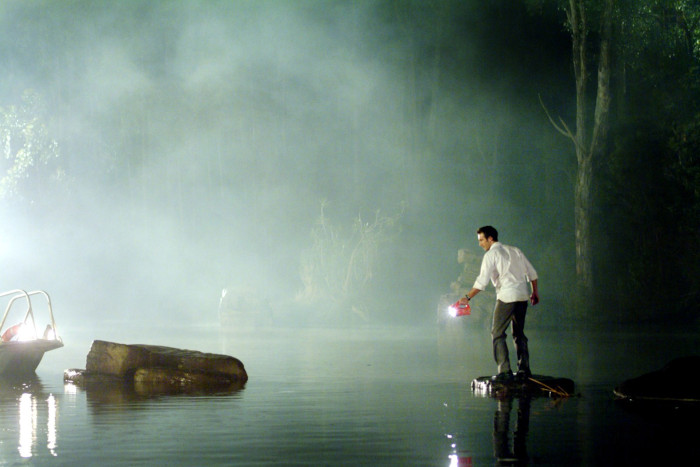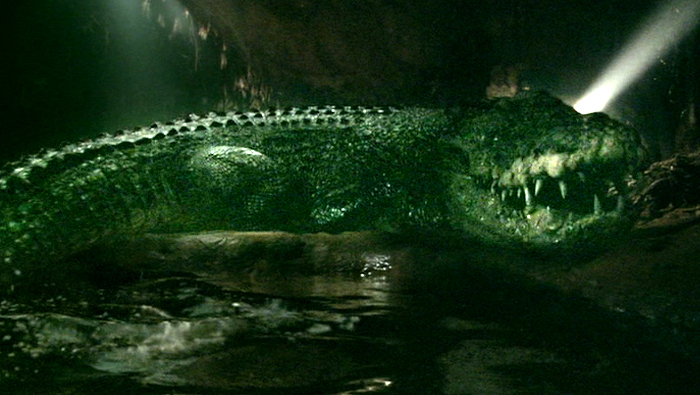Crocodiles and alligators have long been a staple monster in horror cinema, particularly post-Jaws (1975). From Eaten Alive (1976) and Crocodile (2000) to Alligator (180) and Crawl (2019) to the Lake Placid films, these terrifying prehistoric reptiles have almost evolved deliberately to ignite primal fears in humans. Australia has, understandably perhaps, been quite keen on films featuring their native fresh and saltwater crocodiles. In 1987, there was Arch Nicholson’s Dark Age and in 2007, there were a couple of them released very close to each other – David Nerlich and Andrew Traucki Black Water (2007) and Greg McLean’s follow-up to his Outback slasher Wolf Creek (2005), Rogue (there was also an American killer croc film out in the wild in 2007, Michael Katleman’s Primeval).
Rogue begins with American travel journalist Pete McKell (Michael Vartan, a foreigner abroad in the Outback, a recurring theme in Australian horror) joining a crocodile-watching river cruise in a beautiful but remote part of Kakadu National Park of Australia’s Northern Territory, The tour is being led by wildlife researcher Kate Ryan (Radha Mitchell, getting to use her native accent for a change) and initially the trip is routine apart from the intervention of a pair of boorish locals, Neil (Sam Worthington) and Collin (Damien Richardson), who know Ryan of old and are determined to intimidate her. But then, one of the tourists, Everett (Robert Taylor) spots a flare in the distance and Ryan is duty bound to investigate, against the wishes of most of the rest of the passengers (who include among them John Jarratt who had been in both Dark Age and Wolf Creek). They discover a partially sunken wreck but before then investigate, something large in the water rams and disables their boat, leaving them stranded on a small island. The river is tidal, and the tourists can’t stay put for long or they’ll all be underwater – but they can’t get off as a large, territorial and very hungry crocodile is stalking them…

McLean, who also wrote the script, makes little attempt to disguise the fact that he’s basically making Jaws (1975) in the Outback and the film is the better for that. There are no pretensions to be anything other than a straightforward monster film, slickly produced, tautly plotted and smartly written, offering a succession of we-barely-get-to-know-them victims being lined up for grisly deaths which the largely excellent special effects (mostly CGI, only occasionally less than impressive) more than adequately deliver. It breaks no new ground and probably never intended to.
The only time that the film seems to veer into anything other than simple monster movie business comes in the barely glimpsed indigenous people performing a never explained ritual on the cliffs by the river, and Ryan’s concerns that they really shouldn’t be this far up-river as they’re encroaching on sacred ground. There have been some observations suggesting that the crocodile is somehow related to this never explained ritual (it too is having its territory invaded by a group of white people) but one would have to look long and hard for any evidence to support that as a viable argument.

Instead, the story seems to have been inspired by the story of Sweetheart, a 17-foot-long male saltwater crocodile that attacked several boats in the Northern territory during the late 1970s. McLean embellishes the story dramatically – Sweetheart attacked several boats but was never known to have actually killed anyone. Sweetheart was such a popular folk character that on his death in July 1979 (he apparently drowned after being captured alive by a team from the Territory Parks and Wildlife Commission) that his body was stuffed and preserved and has long been a popular attraction at the Museum and Art Gallery of the Northern Territory. Sweetheart lives up his incongruous name compared to the monstrosity in Rogue. It’s an absolute monster (described by one character as “a steam train with teeth”), smart too, constantly sneaking up on hapless tourists and exploiting their stupidity and desperation. McLean cleverly keeps a lot of the early attacks off screen, only really giving us a better look at the crocodile in the incredibly tense finale, which sees McKell descending into the crocodiles cavern lair in an effort to rescue Ryan who its dragged off, presumably to eat later.
McLean is capably supported by a fine ensemble cast, many of them still unfamiliar to non-Australian audiences (Mitchell was the biggest name, despite being billed second) and by the quite gorgeous photography of Will Gibson. One again has to wonder if its even possible to point a camera in the Australian Outback and not capture eye-wateringly beautiful landscapes (“why would I want to leave all this?” asks Ryan earnestly when she reveals that she’s never left the territory) – perhaps not, but Gibson does sterling work with the Yellow Water Billabong, Katherine Gorge, and Arnhem Land locations. Gibson had worked the same magic on McLean’s Wolf Creek, but tragically died, seemingly in a fall, shortly after completing work on Rogue. It was a short but impressive career and if Rogue has to stand as his final work, then it’s a good and very fitting example of his excellent work.

Rogue might not take you anywhere that you haven’t been to before, many times, but it does it very well indeed, making it all the more regrettable that it failed to get a theatrical release in the UK and only showed up in ten cinemas in the States, though it found an appreciative audience on home video. There are lot of crocodile and alligator films around, but Rogue remains near the very top of the pile, a taut thriller with a scary monster and some beautiful photography.